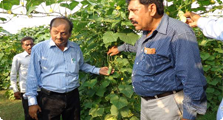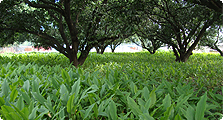Success Story
Case Study on Direct Seeded Rice
Introduction
Visualizing the present scenario of changing climate, sky rocketing food prices and energy crisis, major emphasis is being given on conservation agriculture in improving efficiency, equity and environment that can be realized with application of resource conservation technologies such as utilization of on-farm resources, zero-till, laser leveling, raised bed techniques, direct seeding of rice, managing crop residues, etc. Among Resource Conservation Technologies (RCTs) z direct seeding of rice, is gaining momentum particularly in Indo-Gangetic Plains (IGP) where rice-wheat is a predominant cropping system. Generally manual transplanting of Rice after 2–3 paddling operations with 21 – 35 days old rice seedling is common in the District. This age-old method of planting is used to reduce water percolation and also help in weed control. However, this system is labor intensive, requires huge tractor usage which often delays transplanting of paddy up to second week of August, it ultimately lead is poor tillering, poor grain formation and low yields of rice. Delayed harvesting of rice also delays sowing of wheat that ultimately reduce wheat grain yield. On the negative side, puddling degrades the soil physical properties resulting into poor soil physical conditions for establishment of the next upland crop such as wheat. There has been a lot of research in the region to look at the possibility of establishing rice without puddling. The major hurdle has been paucity of knowledge in the area of good weed management. A total of 1382 mm to 1838 mm water is required for the RW system at different locations in the IGP, accounting to more than 80% for the rice growing season. Thus to save on water, saving must be effected during the rice growing season, the major water user in the RW system. The winter season is short in Eastern Uttar Pradesh. Long-term analysis of the rainfall data clearly indicates that there are three distinct periods of moisture availability. The early moist period (evaporation exceeds rainfall) extends over 12-18 days followed by 93-139 days of a humid moist period wherein precipitation exceeds potential evapo-transpiration. This is followed by a moist period of 17-22 days where once again rainfall is less than evapo-transpiration. If the rice crop can be established early in the first moist period, before the humid period, the rice crop can benefit from the monsoon rain and grow without the need for irrigation. RW system productivity was nearly 12-13 tons per ha when rice was transplanted before 28th June. This was reduced by more than 40% when fields were planted after 15th August (to 6-7 tons/ha). The key issue is if higher system productivity is desired, the rice crop must be planted early with the onset of monsoons by raising rice nurseries with ground water and vacating the main fields early in the season for the succeeding wheat or other crop.
To overcome these problems in rice-wheat cropping system, direct seeded rice (DSR) was demonstrated at farmers’ fields of Kushinagar of U.P along with KVK Farm, Sargatia (Kushinagar) for adoption and promotion of this technology among the farmers. Apart from this technology, improved varieties coupled with integrated plant nutrient management and integrated pest management technologies were also included under Resource Conservation Technology.
District Kushinagar
Kushinagar district is situated on 81 to 24 East longitude and 26 to 45 North latitude. The temperature in the district ranges between 5C and 43.4C and annual rainfall is 907 mm. It is comprised of 4 Tehsils and 14 Blocks. The population of the district is 2.89 million with a density of 996 per km⊃2; and literacy rate of 46.95. Total reported area is 291573 ha, out of which net sown area is 220838 ha and irrigated area is 160898 ha. Soils are sandy loam to loam and clay loam. Typical Bhatt soils are also found which is clay type and have high water holding capacity. The cropping intensity is 151.36%. The major crop grown in Kharif is rice (119909 ha) with the productivity of 20.09 q/ha. Major crop grown in Rabi is wheat (117988 ha) with the productivity of 27.94 q/ha. Fertilizer consumption is 160.98 kg/ha with an application of NPK @ 117.27, 33.55 and 10.17 kg/ha, respectively. Rice-Wheat is one of the major cropping systems that occupied approximately 237897 hectares area in district.
Rainfall Data of last 5-years (June - August)
| Year | Normal Rainfall (mm) | Received Rainfall (mm) |
|---|---|---|
| 2005 | 855.8 | 301.52 |
| 2006 | 855.8 | 359.5 |
| 2007 | 855.8 | 500.5 |
| 2008 | 855.8 | 531.00 |
| 2009 | 855.8 | 77.49 |
Source : http://www.imd.gov.in/section/hydro/distrainfall/webrain/up/kushinagar.txt http://agropedia.iitk.ac.in/?q=content/district-rainfall-data-imds-ganesha-moment
Methodology
DSR through Zero tillage Machine along with improved production technologies in paddy were demonstrated under Rice-wheat cropping system at the farmer field of Kushinagar district of Uttar Pradesh. Under rice-wheat cropping system farmers grown long duration traditional paddy varieties which give them not only low yield but also required more number of irrigation and agronomic practices. During Kharif 2009, frontline demonstrations of improved Paddy varieties through conventional method and direct seeded rice (DSR) were given in 173 farmer’s field in an area of 39.83 hectare. Rice sowing was done by Zero-till Seed cum ferti drill at a seed rate of 40 kg/ha in case of improved varieties and 12.5 kg/ha for hybrid. Weeds are the major threat in direct seeded rice therefore, pendimethaline @ 1 kg a .i. /ha was applied next day after sowing using 500 liter aqueous solution, it was followed by application of 2,4-D @ 0.5 kg a.i./ha in 500 liter of water to control broad leaf weeds and sedges at 25 DAS. One manual weeding was also done at 35 DAS to eliminate some of the escaped wheat. Other cultural operation were similar to transplanted rice except application of butachlore @ 1.25 kg a.i./ha at 2 days after transplanting.
Details of operational area in Kushinagar district under DSR
| S.N. | Name of the Village | Name of the Block |
|---|---|---|
| 1 | Semra Hardo Patti | Tamkuhi |
| 2 | Mukundpur | Seorahi |
| 3 | Habibpur | Seorahi |
| 4 | Tarya | Seorahi |
| 5 | Ramkaranpatti | Seorahi |
| 6 | Bahadurpur | Seorahi |
| 7 | Fazilnagar | Fazilnagar |
| 8 | Dumahi Bagara | Dudahi |
| 9 | Lamkan | Padrauna |
| 10 | Laxmipur | Padrauna |
| 11 | Semara | Padrauna |
| 12 | Paddari | Padrauna |
| 13 | Amavabujurag | Padrauna |
| 14 | Mishirpatti | Padrauna |
| 15 | Sikta | Padrauna |
| 16 | Turpatti | Tamkuhi |
| 17 | Kasia | Kasia |
Performance of Demonstration
Considering the existing situations in the region, large acreage demonstrations of paddy were conducted at farmer’s field. Major emphasis was given to include short duration, high yielding paddy varieties along with Direct Seeded Rice (DSR) with imposition of IPM and IPNM technologies mainly aimed at to save irrigation water optimization of input cost and on through resource conservation. The performance of result of frontline demonstration of Direct Seeded Rice (DSR) in presented in Table 3. Varieties included in demonstration are Rajshree, Rajendra mahsoori, Pusa -44, PB-1 at 104 and hybrid PRH-10 at 69 farmer’s field (Table 4) covering an area of 30.43 and 9.40 hectares respectively.
Results of front line demonstrations on DSR (Varieties)
| S.N. | Crop | Technology Demons-Trated | Variety | No. of Village | No. of Farmers | Area in ha. | Demo. Yield q/ha. | Yield of Check q/ha | Increase in Yield (%) |
|---|---|---|---|---|---|---|---|---|---|
| 1 | Paddy | HYV | Pusa Basmati - 1 | 08 | 12 | 2.42 | H : 38.5 L : 27.5 A : 30.4 |
38.5 | 21 |
| 2 | Paddy | HYV DSR | Rajendra Mahsoori | 07 | 26 | 8.73 | H : 53 L : 29 A : 41.5 |
38.8 | 6.9 |
| 3 | Paddy | HYV DSR | Pusa - 44 | 02 | 04 | 0.41 | H : 46.5 L : 39.5 A : 42.5 |
36.2 | 17.4 |
| 4 | Paddy | HYV DSR | Rajshree | 07 | 62 | 18.87 | H : 61 L : 38.8 A : 46.7 |
20.87 | 123.76 |
| Total | 24 | 104 | 30.43 |
Data in parameter in relation to Technology demonstrated
| Crop | Plant Height(cm) | No. of Tiller/m2 | Panicle Length(cm) | Straw Yield (q/ha) |
|---|---|---|---|---|
| Pusa Basmati -1 | Demo : 122.6 Check : 119.4 |
Demo : 299.8 Check : 263.6 |
Check : 27.26 Demo : 22.8 |
Check : 49.6 Demo : 45.6 |
| Rajendra Mahsoori | Demo : 118.8 Check : 118.4 |
Demo : 428.9 Check : 274.3 |
Check : 20.0 Demo : 19.7 |
Check : 61.2 Demo : 56.4 |
| Pusa – 44 | Demo : 118.4 Check : 112.9 |
Demo : 504.2 Check : 340.0 |
Check : 20.4 Demo : 17.5 |
Check : 56.5 Demo : 50 |
| Rajshree | Demo : 150.0 Check : 160.0 |
Demo : 403 Check : 199 |
Check : 26.5 Demo : 23.4 |
Check : 71.4 Demo : 48.6 |
Economic Impact
| Crop | Average Cost of Cultivation (Rs. /ha.) | Average Gross Return (Rs. /ha.) | Average Net Return (Rs. /ha.) | Benefit Cost Ratio |
|---|---|---|---|---|
| HYV Pusa Basmati -1 | Demo : 21,867.1 Check : 21,779.5 |
Demo : 56,156.1 Check : 42,195.0 |
Demo : 34,288.9 Check : 20,415.5 |
Demo : 2.56 Check : 1.93 |
| Rajendra Mahsoori | Demo : 17663.4 Check : 23722.9 |
Demo : 45433.8 Check : 42528.7 |
Demo : 27770.3 Check : 18805.7 |
Demo : 2.57 Check : 1.79 |
| Pusa-44 | Demo : 18665.5 Check : 21692.5 |
Demo : 46057.5 Check : 39510.0 |
Demo : 27392.0 Check : 17817.5 |
Demo : 2.46 Check : 1.82 |
| Rajshree | Demo : 18791.6 Check : 15625.5 |
Demo : 51189.0 Check : 23371.0 |
Demo : 32397.3 Check : 7746.1 |
Demo : 2.72 Check : 1.49 |
Results of front line demonstrations on DSR (Hybrid PRH-10)
| S.N. | Hybrid | Area in ha. | No. of Farmers | No. of Village | Date of DSR | Date of Harvesting | Average Plants Height (cm) | Average No. of Tillers/sq.m |
|---|---|---|---|---|---|---|---|---|
| 1 | PRH-10 | 9.4 | 69 | 14 | 15-06-2009 to 16-06-2009 | 3-10-09 to 10-10-09 | 114.56 | 438.56 |
| Highest Grain Yield(q/ha) | Average Grain Yield(ha) | Lowest Grain Yield (q/ha) | Average Cost of Cultivation (Rs. /ha.) | Average Gross Return (Rs. /ha.) | Average Net Return (Rs. /ha.) | Benefit Cost Ratio |
|---|---|---|---|---|---|---|
| 76.0 | 44.5 | 63.5 | 23,698 | 68,584 | 44,886 | 2.89 |
Farmer’s Feedback
- Direct seeded rice (DSR) save the time, labour, critical inputs and conserve the natural resources like, soil, water etc.
- DSR also save 30-40 per cent water due to un-paddled field and not raising nursery in advance.
- Short duration and high yielding varieties of paddy reduces the number of irrigation required for paddy and also giving higher yield compare to conventional technologies/varieties.
- In case of demonstrated technologies, weed population is also less due to proper use of herbicides.
- Pusa Basmati gave 21 % less yield than check but net income was more with BC ratio 2.56 due to fine & scented grain.
- Paddy var. Rajendra Mahssori found slightly better than check in respect of yield (6.9).
- Paddy var. Pusa- 44 gave higher yield(17.4) than local check Sarju – 52 .
- Paddy var. Raj Shree gave better performance in water laying areas with 123.76% higher yield over then check.
- Farmers were excited to increase the area of Pusa Basmati due to its fine & scented grain quality & more return.
- Farmers were agreeing to replace var. Sarju – 52 to Pusa -44 in up land area.
- In water logging areas farmers were quite impressed with DSR (Raj Shree variety).
- PRH-10 is short duration hybrid and farmers can sow sugarcane timely after harvesting of rice.
- PRH-10 performance was good in drought condition and minimum loss due to drought.
- Shoot borer problem is found to a lesser extent during maturity stage in comparison to other variety.
Farmers showed a great response in adopting the techniques of DSR as well as short duration high yielding varieties of paddy along with other recommended technologies of balance use of fertilizers, use of herbicides and less irrigation in paddy field.
Environmental Benefits
- Improving water use efficiency and conservation (important as water becomes scarcer).
- Helping to control erosion.
- Reducing the amount of N that "leaks" into the environment.
- Providing environmentally friendly options for managing crop residues.
- Reducing soil compaction; and bettering soil physical structure over.
New Technologies Transform lives of Lal Ji Kushwaha
Shri Lal Ji Kushwaha s/o Late Sri Mahesh Kushwaha is a progressive farmer who lives in village Dumahi, Purabpatti, P. O. Dharampur Parwat, Block Dudahi of district Kushinagar, U.P. He is an intermediate pass young man who believes in hard work. His father had a small land holding and also possessed a small shop. He is a laborious and sincere person, who supported his father to run the shop and side-by-side studied and completed intermediate. The shop was not running well and about to be closed so he could not continue his study due to financial crunch. Being elder son of family, parent wanted him to earn money to meet out the family expenditures. He worked as a teacher in a private nursery school for two years but payment was not sufficient to overcome the economic stresses. Then he decided to go outside for a job, and went to Delhi, spent four months to search job but failed to get an appropriate job. He came back to his village and decided to close the shop and help his father to grow vegetables on his small farm land (1 acre). Being a member of Kushwaha family (vegetable growers) he started growing brinjal in his parental land with involvement of all family members (father, mother and younger brother) for livelihood.
In 2005, Shri Lal Ji Kushwaha came in contact to recently established Indian Institute of Vegetable Research, Seed Production Centre, Sargatia, Kushinagar and shown interest to adopt new technologies in vegetable production. In the mean time he got an opportunity of an exposure visit to Indian Institute of Vegetable Research Varanasi through National Horticulture Development Foundation (NHRDF) Deoria. After visiting the IIVR Varanasi, he was impressed to see the new varieties and production technologies of vegetables and wanted to adopt the same at his field. At the same time, Krishi Vigyan Kendra was established in IIVR-SPC campus at sargatia, Kushinagar. He already had a contact with Shri Rajneesh Srivastava, S.M.S. (Horticulture) who at that time looking after the IIVR-SPC, Kushinagar. With the establishment of Krishi Vigyan Kendra, Shri Rajneesh Srivastava put a front-line demonstration on cowpea in Zaid 2007 in his field. Lal Ji was impressed to see the overall growth, yield and quality of cowpea pods of the variety Kashi Kanchan. In the next season, considering the overall performance he decided to cultivate cowpea variety Kashi Kanchan in 1.5 acre area. He also took 1.0 acre land on lease and expanded the cultivation of cowpea crop. With these efforts, he got net return of Rs. 61000=00 from the sale of green pod. Another timely suggestion from the S.M.S. was given to produce seeds from the last picking. Following this advice, he produced 250 kg of seeds and sold it at the rate of Rs. 70=00 per kg and earned Rs. 17500=00. To extract more profit, he leased some more land and started cultivation of tissue culture raised banana in 0.3 ha farm land and got a net return of Rs. 1.0 lac.
Lal Ji Kushwaha later made a ‘Machaan’ (a local form of bower made from bamboo and plastic rope) and started growing hybrid (Chaman) bitter gourd in 0.32 ha area and got a return of Rs. 30000=00. On the advice of Shri Rajneesh Srivastava, S.M.S., he started cultivating coriander and ginger beneath the machaan of bitter gourd. As per the advice for early fruiting, he started preparing nursery of bitter gourd in polythene bags under low cost plastic tunnels so that he could make an early planting. Such an advice realised him an early bitter gourd crop and fetched a good return. To double the benefit and utilize the land beneath the machaan he planted ginger in the month of June and later in July he sown coriander. He was amazed with the produce and got returns of Rs. 60000=00 from bitter gourd, 40000=00 from ginger, and 22000=00 from coriander from same piece of land. In this way with the intervention of new technologies from KVK, Sargatia, Kushinagar, he earned a total income of Rs. 1,22,000=00 in one year. With the initial success with horticultural crops, next year (2009-10) he purchased 1.0 acre land and started cultivating ginger with bitter gourd and banana. This was a turning point of his life and he could make handsome money of Rs. 3.0 lacs only from sale of ginger against Rs. 62000=00 total cost of cultivation in 1.0 ha area. In the year 2009, his mother died and his father suffered from numerous health problems. In this critical situation, he single headedly took all the responsibility of the family.
Lal JI always wanted to adopt new technologies and tools in agriculture and he showed interest to grow papaya which was a new crop in his area. He contact to Subject Matter Specialist, Horticulture and get technologies for growing papaya. He procured seed of papaya hybrid "Sinta" in the month of February 2012. He sown seeds in prepare bed and after germination when plant reached two to four leaf stage transferred them in 22 x 10 x 8 cm sized polybag and take care for about two months. In the first week of April he planted papaya in 0.11 ha area, 275 plants with spacing of 2 x 2 m. The total cost of cultivation Rs. 21600=00 and get return of Rs. 100320=00 with the yield of 70.0 q (626 q/ha) with B:C ratio of 4.64:1 in 14 months.
On the basis of earning from agriculture he purchased 1.5 acre land and took 1.0 acre land on lease in last seven years. At present he is cultivating following crops in his field: banana (0.4 ha), papaya (0.11 ha), ginger (0.08 ha), bitter gourd (0.32 ha), coriander (0.08 ha), pointed gourd (0.11 ha) and cowpea (0.15 ha) and also possessed a cow.
Proving that agriculture is still a good source of livelihood, Shri Lal Ji Kushwaha along with his wife Smt. Krishnawati Devi devote much of his time and labour on the field. He says new technologies which he got from KVK, Sargatia, Kushinagar transformed his life. On that basis his two sons are studying in Allahabad, the elder one has completed Intermediate and preparing for engineering and the younger one is studying in high school. Lal Ji Kushwaha happily gives the credit for all his success to the new horticultural production techniques, which he learnt from KVK, Sargatia, Kushinagar and adopted on his farm land. He also got several prize from different organisation and role model farmer of his and nearby villages.
Adoption of Cowpea var. Kashi Kanchan for better income in short duration
Under the circumstances a massive demonstration of cowpea variety Kashi Kanchan were undertaken at 76 farmers field in different villages of district Kushinagar during 2007-10 with the objectives to increase the farmers income in short duration as well as improve the soil health.
Cowpea (Vigna unguiculata) is a commercial vegetable, grown around the year except October-February and all the type of soils. But, it requires a fertile soil for better performance. Being a legume, cowpea is a promising crop for controlled ecological support system, since foliage, green pod and seeds are edible with low fat, high complex carbohydrate, moderate proteins and adequate minerals. It also improves the soil health by enrich the organic matter and nitrogen recycling. Therefore, it is known as potential crop for human as well as soil health. It is also well suited in rice-wheat cropping system.
It was observed by the KVK farmers of district Kushinagar grown local varieties of cowpea which were spreading type, long duration maturity with low yield, poor quality and highly sensitive to golden yellow mosaic virus. Therefore, KVK planed to demonstrate the improve variety Kashi Kanchan which was developed by Indian Institute of Vegetable research, Varanasi. It is photo-insensitive, dwarf (40-45 cm height) and short duration variety which takes 40-45 DAS to flowering and ready to harvest in 50-55 DAS. Pods are 20-30 cm long, green in colour, soft, flashy, and free from parchment layer. This variety is also resistance to golden yellow mosaic virus.
During demonstration, it was recorded that the yield of variety Kashi Kanchan found 38.44 % higher than local variety with average yield 122.8 q/ha and taken 110-120 days to harvesting.
Farmers were very impressive with the performance of variety Kashi Kanchan due to higher yield, quality and resistance to mosaic virus attack, resulting better income in very short duration (50-60 DAS). They have also observed that the yield of succeeding crops is also increasing because of enriching the soil health. After seeing the result of demonstration, this technology has been adopted by the more than 85





